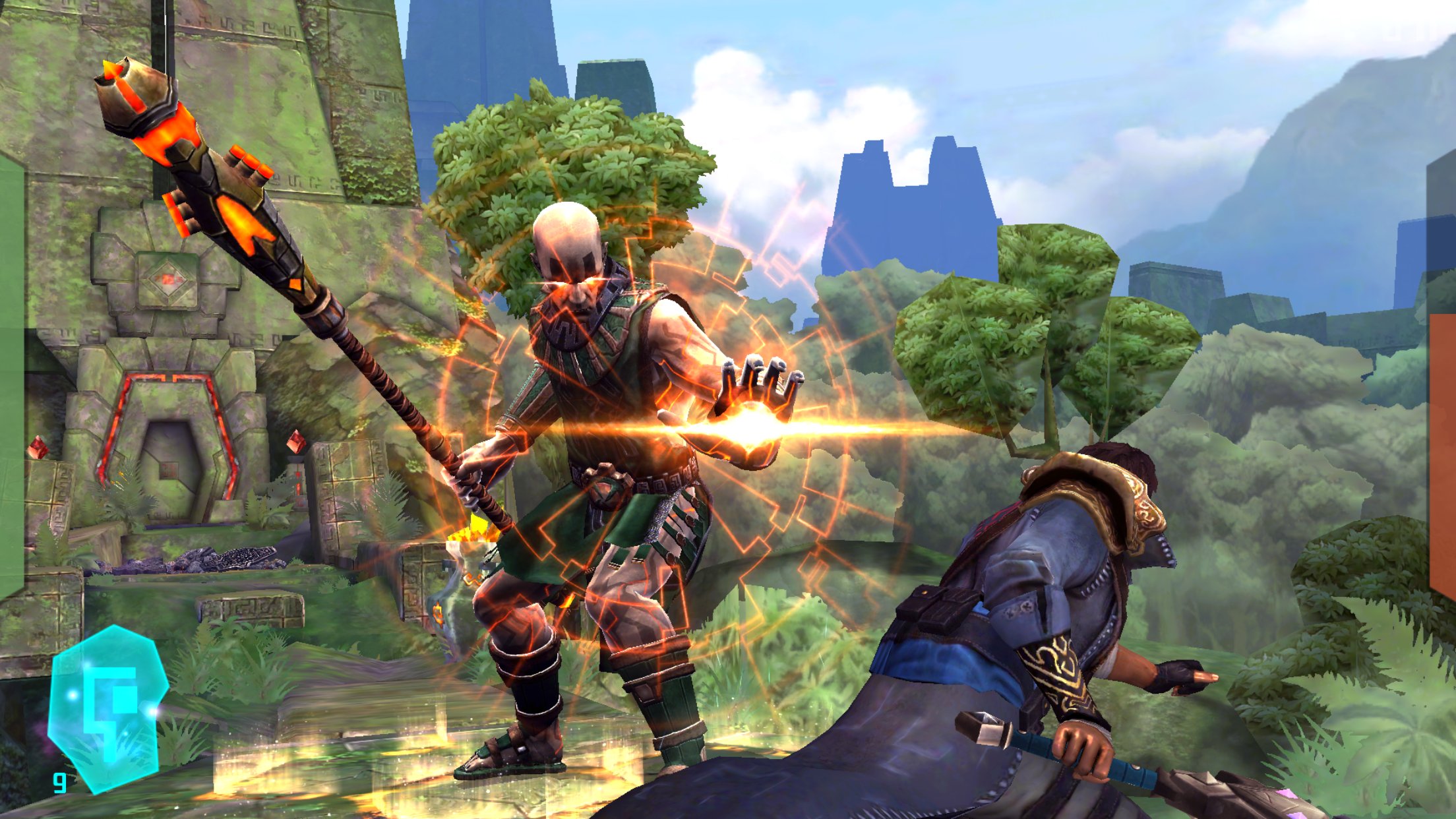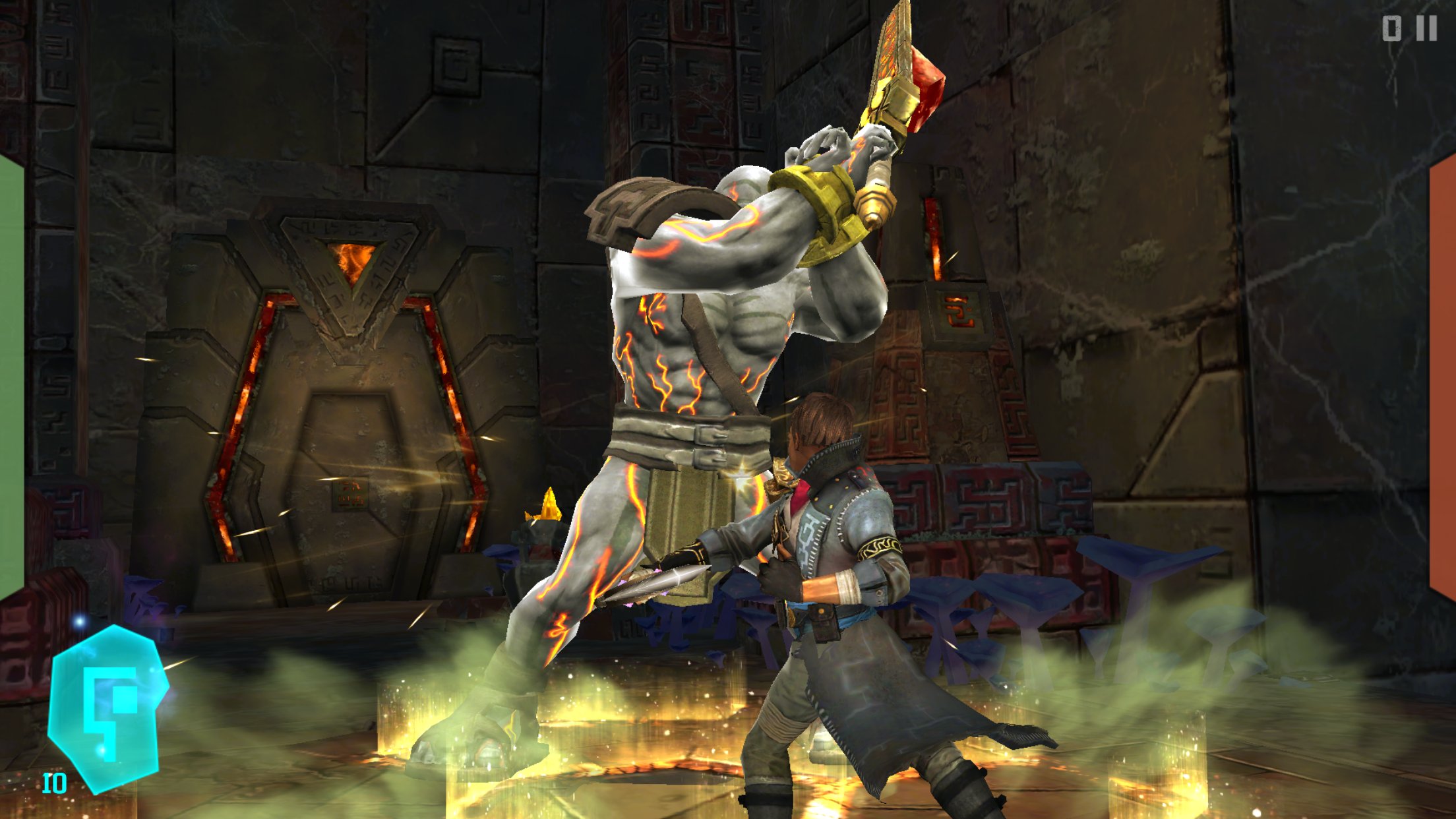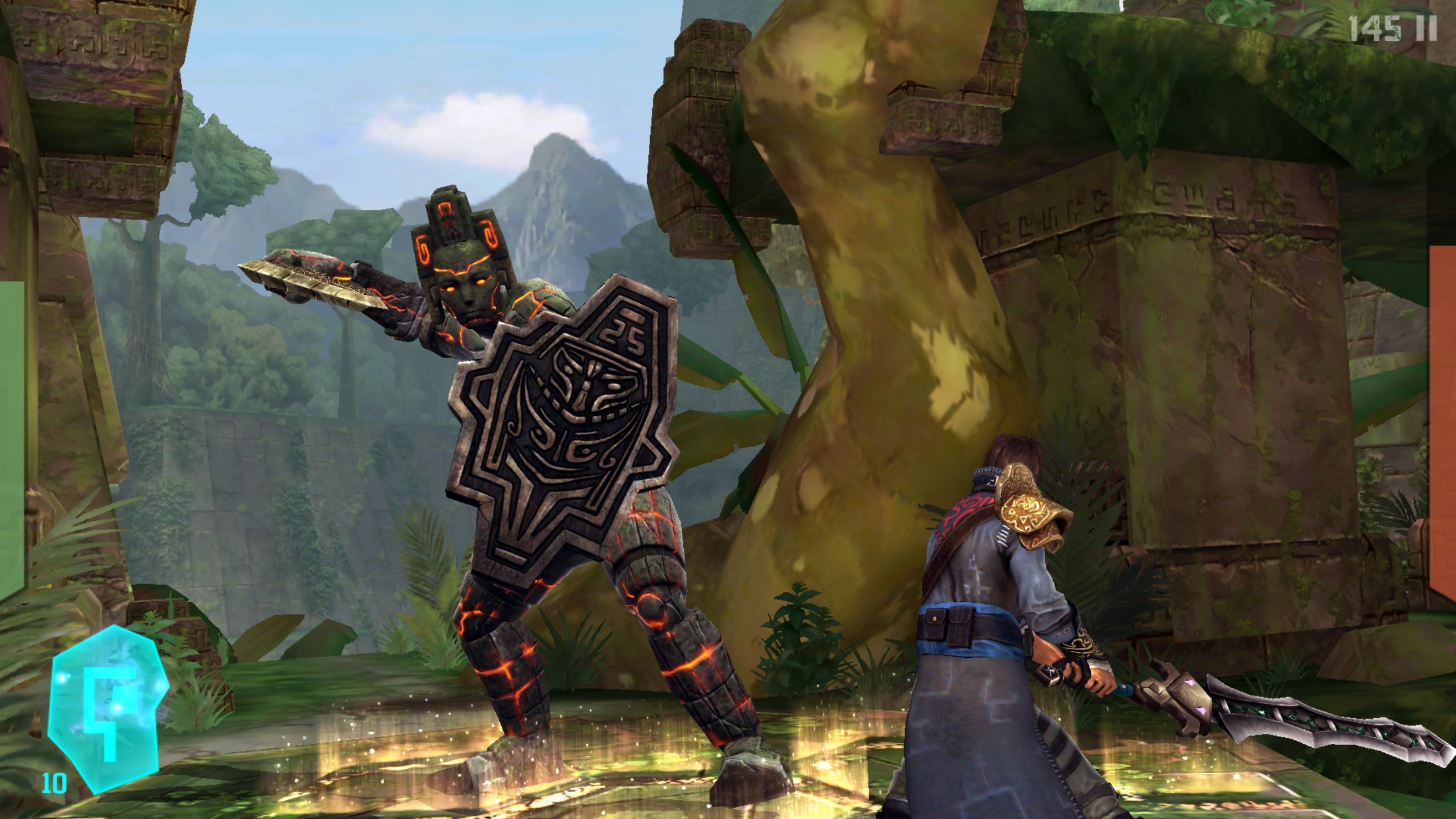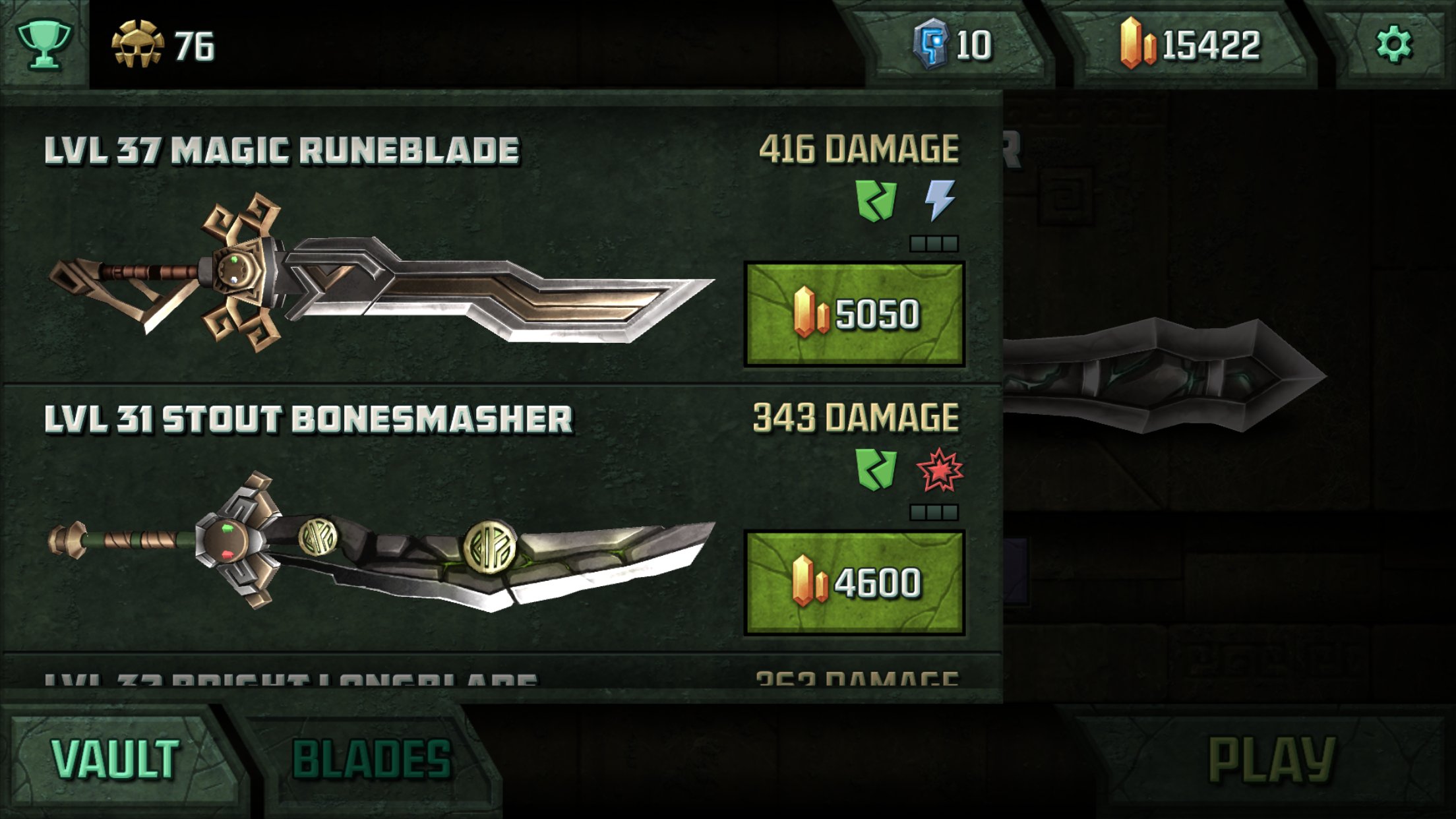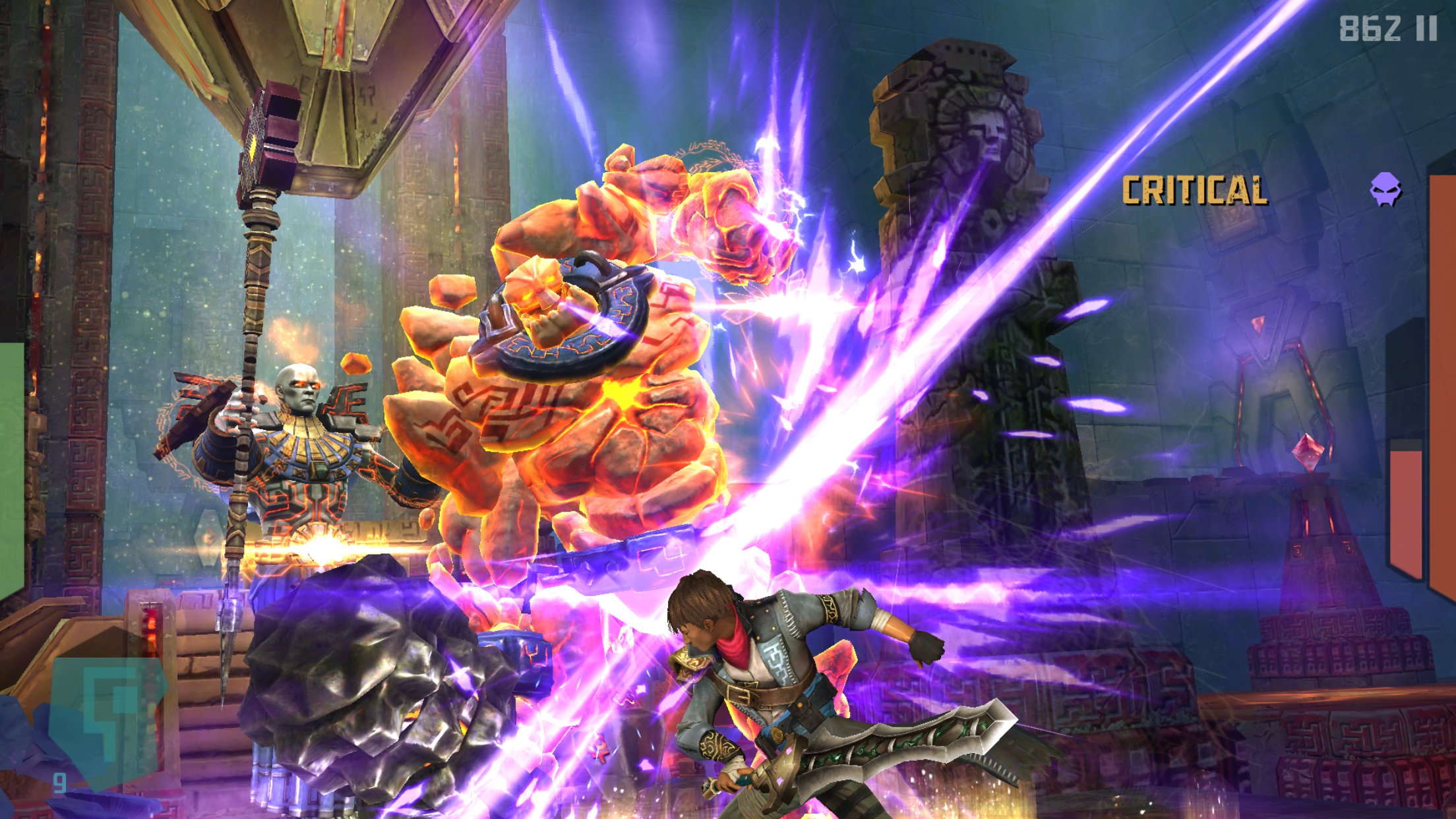 Stormblades (Free) is Diet Infinity Blade ($5.99). I say this not to demean the game or to put it down, it’s just that its motivations are patently obvious. This takes Infinity Blade‘s combat, complete with its directional attacks and dodging in one-on-one battles against bigger enemies, but stripping down a lot of the extra features from the combat and the meta-game. The combat is simpler but familiar, the game is level-based, and there’s no ‘exploration’, it’s just about advancing from one challenge to the next, buying better weapons and more potions along the way to keep up with the advancing difficulty. It’s not as deep a game and can be a bit repetitive, but it also takes away some of the annoyances that Infinity Blade could sometimes get bogged down in, especially once Infinity Blade 3 ($6.99) rolled around. And as a free-to-play game, it’s surprisingly fair. Stormblades is an interesting little package for those who want a familiar experience, but streamlined.
Stormblades (Free) is Diet Infinity Blade ($5.99). I say this not to demean the game or to put it down, it’s just that its motivations are patently obvious. This takes Infinity Blade‘s combat, complete with its directional attacks and dodging in one-on-one battles against bigger enemies, but stripping down a lot of the extra features from the combat and the meta-game. The combat is simpler but familiar, the game is level-based, and there’s no ‘exploration’, it’s just about advancing from one challenge to the next, buying better weapons and more potions along the way to keep up with the advancing difficulty. It’s not as deep a game and can be a bit repetitive, but it also takes away some of the annoyances that Infinity Blade could sometimes get bogged down in, especially once Infinity Blade 3 ($6.99) rolled around. And as a free-to-play game, it’s surprisingly fair. Stormblades is an interesting little package for those who want a familiar experience, but streamlined.
While first looks at Stormblades seemed to peg it as the endless runner Infinity Blade, the running is just a part that serves as a breather between battles, and to get from one fight to the next, with the ability to smash items containing the game’s currency, called essence. The combat is reliant on what would be ‘scratches’ in other games, so you’ll be constantly swinging at enemies, while trying to be aware of when you need to parry their attacks, and when you need to double-tap to dodge un-parryable attacks, though pretty much everything can be dodged. Openings will pop up, but you have no combo attacks that you can do, so directionality is pretty much just for parrying. You can break enemy armor, and weapons you get will have special properties, but there’s not a lot of special wrinkles beyond what level one introduces.
There’s the occasional power strike that pops up, but the indicators for these are sudden and subpar: I miss most of the opportunities because I’m busy frantically attacking, and the light blue swipe indicator is hard to see. As well, moments where the action slows down are very inconsistent as to whether those are actually power attack moments, or if they’re just a signal that you’re going into armor-breaking berzerker time. The combat ultimately boils down to doing as much damage as quickly as possible, and not taking damage. You have potions, which don’t just heal you, but heal you more based on how much you hit the enemy with while they’re active, and they actually can stun enemies so you can wail away on them.
The game is level-based with a three-star system, except Stormblades calls them relics. Each level tends to have the same environment whenever you play it, and later levels start to introduce new enemies, and ones with trickier moves to dodge and parry, but the enemies are always random. Levels always contain 5 regular enemy battles, with the last battle being against a boss enemy. You get points for killing an enemy as quickly as possible, with a maximum of 200 points, getting a bonus 100 points for not taking any damage. Bosses give you more points, and a bonus for health left over. The relic system is actually pretty simple: if you get 1000 points, you get one relic, and I don’t think it’s possible to get zero relics. 2000 points gets you two relics, and 3000 gets you three. It’s always like that, the levels are all structured the same, so things can feel quite same-y after a while, but the game at least has consistent rules. And you can tell when you may need to start upgrading your weapon if you start to get fewer points for kills, for example.
Stormblades is free-to-play, and from Kiloo, there was definitely a fear in the back of my mind that this would be a game that gets hung up on the monetization, eventually feeling like it wants to make money off of me. Well, I’m admittedly shocked to say that, hey, this game actually does free-to-play in a solid way. There are no energy timers whatsoever, for starters, which helps because grinding to get more money and to get more relics on a level is something you can just do over and over again, which can also net you more and more essence. Essence is also the game’s one currency, there’s no hard currency at all.
The health potions are a simple cost of 200 essence, with no limit to how many you can buy, though you’re ideally going to want to use as few of them as possible, as levels usually net you a little more than that as a base essence gain, with 100 essence bonuses for each relic you pick up. Thankfully, even failed levels give you the essence you collected for kills and what you picked up in the environment, so you’re not getting hosed out of anything when you die, outside of the potions you used. So, I’d probably save them until you reach the boss of each level, just to be safe. I’d love the ability to watch a video ad to get another potion, though.
The game does start to ramp up its difficulty, and you can start to feel the crush for more money, but the game never really leaves you high and dry. The enemies start to get harder, but dodging and reflecting their attacks just means that you have to catch on to their new wrinkles, and if you were a rapid attacker like I once was, you may need to calm down on the attacking, and be a bit more deliberate so that you can catch and dodge everything coming at you. You will need more powerful weapons as time goes on, which help in keeping you alive by making battles shorter. As well, points are earned based on how quickly you kill enemies, so better weapons are a huge help.
You get new weapons for free throughout the game at certain milestones, which also introduce new weapon abilities, like doing damage on parries and bonuses for rapid sequences of strikes. However, the most powerful weapons must be bought with essence. Buying these weapons without doing any in-app purchases isn’t necessarily easy, but it’s quite possible – you just need to go back and grind on earlier levels that you didn’t get three relics on, being diligent about saving up essence in order to buy those better weapons. Again, this isn’t easy to do, but it can be done if you don’t want to pay. While the lowest-cost IAP is $4.99, it nets you a solid amount of coins that can buy you a powerful sword or two, at least.
The game really does make it worth waiting for better swords, if you can hold out, as the damage really ramps up over time. By the time I got ready to drop $4.99, I felt that I had definitely gotten my money’s worth out of Stormblades, such that I had zero qualms with dropping the cash. You also can’t cheat the system, like in Infinity Blade 3, where you can just buy the Infinity Blade and go to town on every enemy because you bought the most powerful weapons that money could buy. I know, because they had that one in-game event around Christmas 2013 where you could get a couple hundred dollars worth of currency for free and I bought all the best stuff I could, and it made the game super-easy. Not so with Stormblades, as there’s only three swords that you can buy at any one time, so you can never really beat the difficulty curve completely.
The simplicity is the benefit and the drawback of Stormblades. There’s only three swords that you can buy at any one time, so if you want a sword with a particular set of characteristics, then you’re waiting for the one you want to pop up. You have no armor to buy, but no way to customize how your character looks. As well, the structure of the game means that really, each level is really not that different from the last, and the progression feels it’s just a matter of how far down the road you’re willing to go, with a series of carefully-regulated experiences along the way. Infinity Blade‘s story was fantasy nonsense in games two and three, but Stormblades has practically no story whatsoever. And the levels have such loose rules to them that sometimes beating a level or getting three relics is a matter of getting a luck of the draw for enemies and a boss that you prefer. Heck, I’m kind of shocked this game isn’t playable in portrait mode, because it really feels like it’s going for that kind of casual player who wants a very consistent and casual experience.
Stormblades is visually very impressive, and clearly pushing the device hardware, which is interesting because of the fact that this is meant to be a pick-up-and-play game. I find that sometimes games like these defeat the purpose of having such systems when they’re going to kill your battery. While I am the kind of person who doesn’t travel anywhere without a battery backup, because I’m paranoid about my phone dying, not everyone is as enlightened as I am. If I was someone who was looking for a good pick-up-and-play game, I’d be hesitant to play this because it would mean my phone’s dying sooner than I’d want it to. Still, the powerful hardware does exist, the game looks great, with vibrant colors everywhere, and iPads exist for a reason, eh? Plus, if you log in with Facebook, there’s functional cloud saves! You have to complete the tutorial on a new device, which is annoying, but once you get the chance to log in, you can sync your progress and it works like a charm.
Whether Stormblades feels dumbed-down to the point of losing its taste will depend on how much depth you demand of your games, or whether you expect all games to have a certain amount of features. Stormblades strips a lot down, and while I think there are some weaknesses introduced, I also kind of like that this is a game that takes that Infinity Blade experience and makes it something I can pick up for a few minutes, and can play without worrying about my armor being mastered and having to buy a new one. There is the currency crunch that’s standard to games now, but it’s a system the player never has to really fight against, they can catch up to it. And I like that. This is a free-to-play game that’s a lot more honest than most about what they’re going after and what they’re trying to do. And Stormblades does get the basics of the combat down to be a fun game you can play for as long as you want. If you’re tired of waiting for the next Infinity Blade, this might be just a good enough substitute.
